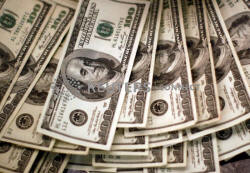Dollar slips; markets in wait-and-see mode before U.S.
debate
 Send a link to a friend
Send a link to a friend
[ September 29, 2020] By
Elizabeth Howcroft September 29, 2020] By
Elizabeth Howcroft
LONDON (Reuters) - The dollar index slipped
from recent two-month highs on Tuesday, as markets waited for the first
debate between the U.S. presidential candidates, signs of progress in
U.S. fiscal stimulus talks, and economic data including German
inflation.
After racking up its biggest weekly gains since early April last week as
markets turned cautious and sought safer assets, the dollar gave up some
gains on Monday and edged down further on Tuesday, ahead of the debate
between President Donald Trump and Democratic challenger Joe Biden.
The 90-minute televised debate at 9 p.m. ET (0100 GMT) will be watched
by investors looking for a steer on the candidates' prospects.
ING strategists told clients in a note that a rise in Trump's perceived
chances was likely to boost the dollar, "although the non-negligible
risk of a contested outcome (along with the ultra-dovish Fed) may keep
the dollar’s upside somewhat capped in the run-in to the vote".
Commerzbank FX and EM analyst You-Na Park-Heger said the question of
whether Trump would accept the result if he was defeated, or instead
trigger a period of uncertainty, was in fact the decisive factor for the
dollar.

"The debate is unlikely to provide any new insights in this respect and
we therefore do not expect it to move EUR-USD in a major way," she
wrote.
At 1104 GMT, the dollar was at 94.033 against a basket of currencies,
down around 0.1% on the day <=USD>.
Craig Erlam, senior market analyst at OANDA, said that the dollar
rebound could continue in the short term, and that Tuesday's pause could
be due to month-end profit-taking, as investors wait until after the
debate to enter new positions.
"I think there is going to be an overall view of ‘step aside’ as far as
today is concerned - sit on the fence, let's just see how this evening
unfolds," he said.
European shares were down, but riskier currencies strengthened, a move
that OANDA's Erlam said was driven by the dollar.
The New Zealand dollar was up 0.5% at 0.6583 <NZD=D3> and the Australian
dollar up 0.6% on the day at 0.71135 <AUD=D3> - both recovering from
sharp falls last week.
[to top of second column] |

U.S. dollars are counted out by a banker counting currency at a bank
in Westminster, Colorado November 3, 2009. REUTERS/Rick Wilking

The yen was steady against the dollar at 105.615 at 1055 GMT <JPY=EBS>.
Markets were also waiting for developments in talks over aid for people affected
by the coronavirus in the United States.
U.S. House of Representatives Speaker Nancy Pelosi said on Monday that
Democratic lawmakers were unveiling a new $2.2 trillion fiscal stimulus bill,
which she said was a compromise and less costly as it covers a shorter period of
time.
The pound strengthened, boosted by hopes for a Brexit deal and the Bank of
England's deputy governor saying he thought the floor for the central bank's key
interest rate was 0.1%.
The euro was up 0.2% on the day at $1.1687 <EUR=EBS>, while the Swiss franc was
steady against the euro at 1.0786 <EURCHF=EBS>.
European Central Bank policymakers are increasingly divided over how to steer
Europe's economy through a second wave of COVID-19 infections.
More than 1 million people have died globally due to the coronavirus.
German inflation data for September is due at 1200 GMT and is expected to come
in at -0.1%, according to a Reuters poll.

"Barring a negative CPI read in Germany, EUR/USD should test 1.1700 today ahead
of the US Presidential debate as improved sentiment may take some support off
the USD," ING wrote.
U.S. consumer confidence data for September is due at 1400 GMT.
(Graphic: Dollar index - https://tmsnrt.rs/3cFr56A)
(Reporting by Elizabeth Howcroft; Editing by Nick Macfie and Kevin Liffey)
[© 2020 Thomson Reuters. All rights
reserved.] Copyright 2020 Reuters. All rights reserved. This material may not be published,
broadcast, rewritten or redistributed.
Thompson Reuters is solely responsible for this content. |